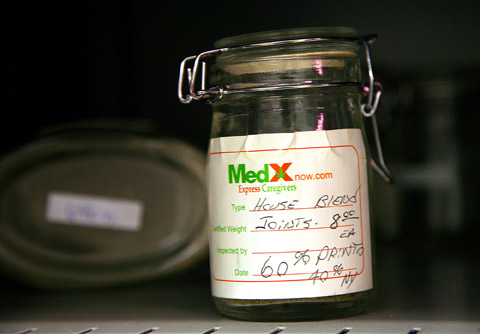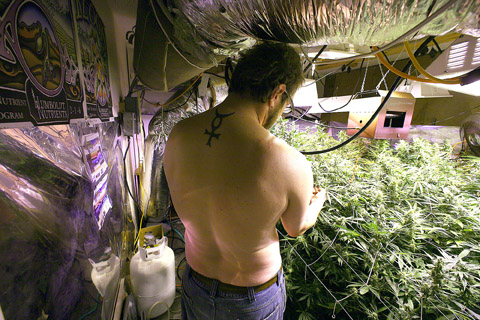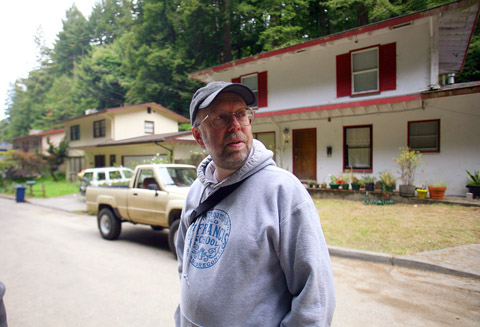There is probably no marijuana-friendlier place in the US than here in Mendocino County, where plants can grow more than 4.5m high, where medical marijuana clubs adopt stretches of highway, and the sticky, sweet aroma of cannabis fills this city’s streets during the autumn harvest.
Medical marijuana was legalized under state law by California voters in 1996, and since then 11 other states have followed, even though US federal law still bans the sale of any marijuana. But some frustrated residents and law enforcement officials say the California law has increasingly and unintentionally provided legal cover for large-scale marijuana growers — and the problems such big-money operations can attract.
“It’s a clear shield for commercial operations,” said Mike Sweeney, 60, a supporter of both medical marijuana and a local ballot measure last Tuesday that called for new limits on the drug in Mendocino.

PHOTO: NY TIMES NEWS SERVICE
The outcome of the ballot measure is not known, as votes are still being counted, but such community push-back is increasingly common even in the most liberal communities.
Under the 1996 law, known as Proposition 215, patients need a prescription to acquire medicinal marijuana, but the law gave little guidance as to how people were to acquire it. That gave rise to some patients with marijuana prescriptions growing their own in limited quantities, the opening of clubs or dispensaries to make it available and growers going large scale to keep those outlets supplied.
In Arcata, home of Humboldt State University, where town elders say roughly one in five homes are “indoor grows,” with rooms or even entire structures converted into marijuana greenhouses.

PHOTO: NY TIMES NEWS SERVICE
That shift in cultivation, caused in part by record-breaking seizures by drug agents of plants grown outdoors, has been blamed for a housing shortage for Humboldt students, residential fires and the powerful — and distracting — smell of the plant in some neighborhoods during harvest.
In May, Arcata declared a moratorium on clubs to allow the city council time to address the problem. Los Angeles, which has more than 180 registered marijuana clubs, the most of any city, also declared a moratorium last year.
All told, about 80 California cities have adopted moratoriums on the dispensaries with more than 60 others banning them outright, according to Americans for Safe Access, which advocates for medical marijuana research and treatment. In addition, 11 counties have also adopted some sort of ban or moratorium.

PHOTO: NY TIMES NEWS SERVICE

April 28 to May 4 During the Japanese colonial era, a city’s “first” high school typically served Japanese students, while Taiwanese attended the “second” high school. Only in Taichung was this reversed. That’s because when Taichung First High School opened its doors on May 1, 1915 to serve Taiwanese students who were previously barred from secondary education, it was the only high school in town. Former principal Hideo Azukisawa threatened to quit when the government in 1922 attempted to transfer the “first” designation to a new local high school for Japanese students, leading to this unusual situation. Prior to the Taichung First

When the South Vietnamese capital of Saigon fell to the North Vietnamese forces 50 years ago this week, it prompted a mass exodus of some 2 million people — hundreds of thousands fleeing perilously on small boats across open water to escape the communist regime. Many ultimately settled in Southern California’s Orange County in an area now known as “Little Saigon,” not far from Marine Corps Base Camp Pendleton, where the first refugees were airlifted upon reaching the US. The diaspora now also has significant populations in Virginia, Texas and Washington state, as well as in countries including France and Australia.

On April 17, Chinese Nationalist Party (KMT) Chairman Eric Chu (朱立倫) launched a bold campaign to revive and revitalize the KMT base by calling for an impromptu rally at the Taipei prosecutor’s offices to protest recent arrests of KMT recall campaigners over allegations of forgery and fraud involving signatures of dead voters. The protest had no time to apply for permits and was illegal, but that played into the sense of opposition grievance at alleged weaponization of the judiciary by the Democratic Progressive Party (DPP) to “annihilate” the opposition parties. Blamed for faltering recall campaigns and faced with a KMT chair

Article 2 of the Additional Articles of the Constitution of the Republic of China (中華民國憲法增修條文) stipulates that upon a vote of no confidence in the premier, the president can dissolve the legislature within 10 days. If the legislature is dissolved, a new legislative election must be held within 60 days, and the legislators’ terms will then be reckoned from that election. Two weeks ago Taipei Mayor Chiang Wan-an (蔣萬安) of the Chinese Nationalist Party (KMT) proposed that the legislature hold a vote of no confidence in the premier and dare the president to dissolve the legislature. The legislature is currently controlled